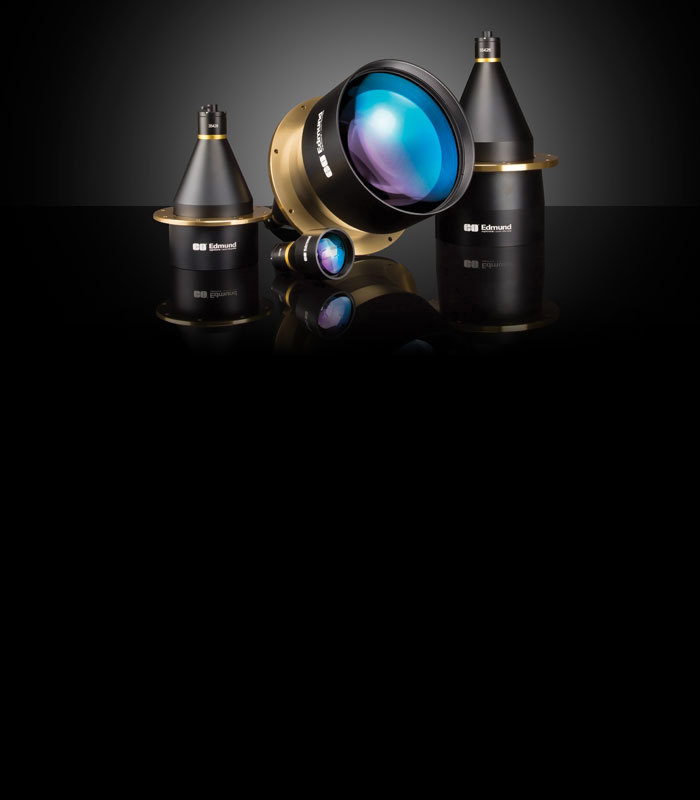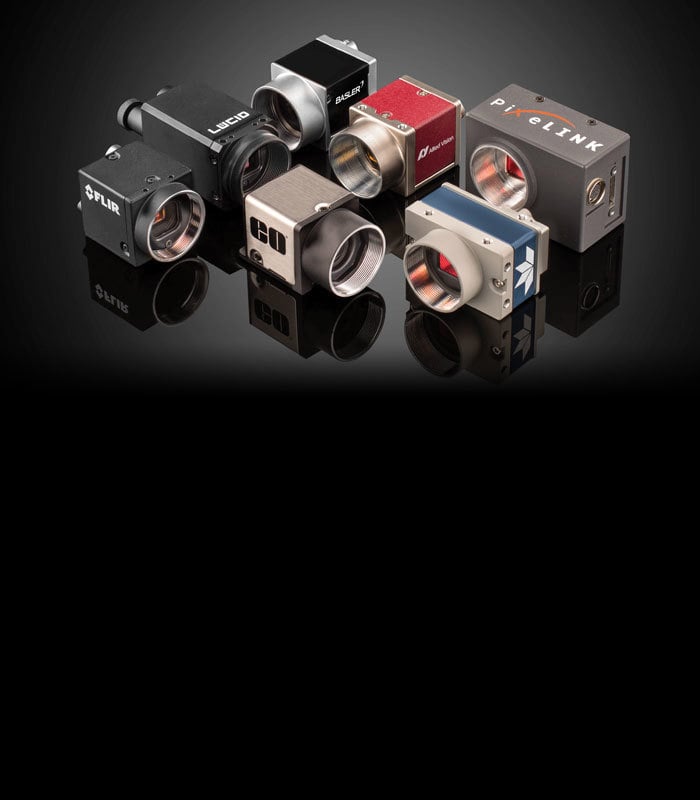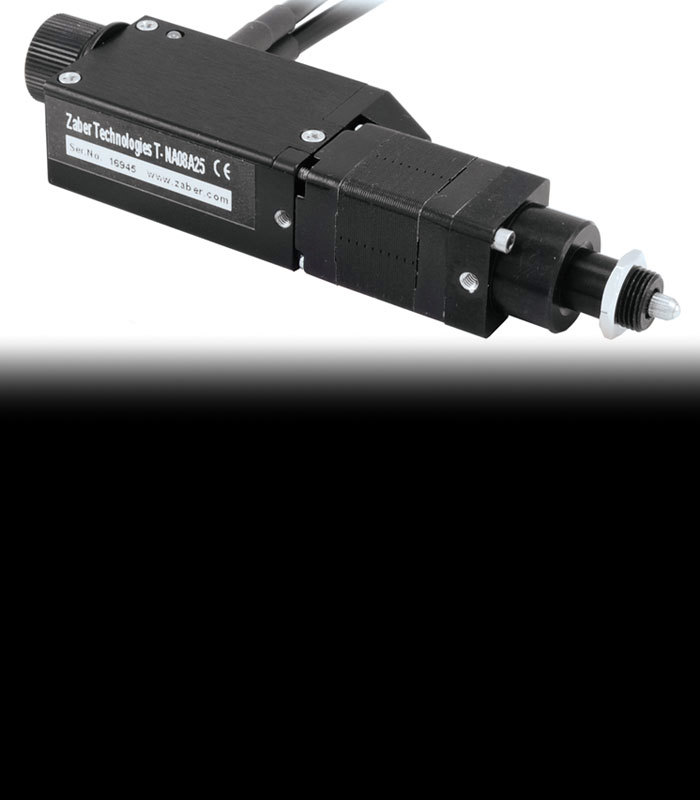
The future of respiratory health depends on advancements in our understanding of lung function. The Laboratory of Biocolloids and Biointerfaces at University of Hawaii at Manoa uses optical systems to study interfaces of droplets for respiratory research.
Dr. Zuo and his team use a method of study known as drop shape analysis to determine surface tension by precisely measuring the silhouette of a droplet. The most important factor in the study of these droplets is the ability to clearly visualize their shape and borders with sharp edge contrast. To do this, a droplet is backlit by the telecentric illuminator, which faces a camera on the opposite side. The camera is fitted with a telecentric lens to eliminate parallax error so that the size and shape of the droplet can be accurately gauged. When the system is in use, the respiratory simulator mimics the behavior of human lungs while the imaging system captures the changing properties of the oscillating droplet.
The telecentric illuminator is a key factor in the success of this system because it emits collimated, parallel light rays, which result in crisp edges when imaging an object. With the inclusion of the telecentric illuminator in the system, the droplet’s shape is clearly captured, and its surface tension is determined using the Laplace equation of capillarity. The telecentric imaging lenses further improve accuracy by eliminating parallax, or perspective, error which, in conventional imaging systems, makes further-away objects look smaller than those that are closer. More information can be found in our telecentric illumination and imaging application notes at the bottom of this page.
A basic overview of the system layout used in Dr. Zuo’s lab is shown below which uses telecentric backlight illuminators, telecentric imaging lenses, cameras, and supporting optomechanics, all provided by Edmund Optics (Figure 2).

Lung surfactant research involves studying the surface tension of purified animal lung surfactants and how they act in a human respiratory simulation upon compression and expansion of the surfactant film. This application has gained traction over the years and is employed in hospitals across the mainland United States, including Cincinnati Children’s Hospital and SUNY Upstate Medical University. The main benefactors of the research would be infants in a neonatal intensive care unit (NICU) setting as premature infants are susceptible to respiratory distress syndrome.

In the early stages of the COVID-19 pandemic, relatively little information was known about how the virus spread. Once it became apparent that the virus was airborne and was being transmitted via respiratory droplets, the Laboratory of Biocolloids and Biointerfaces seized the opportunity to contribute to the pandemic response. The team worked to simulate aerosol transmissions of the virus with the technology previously developed to study lung surfactant. Surfactants were utilized in this application since they act as a first line of defense in protecting the lungs from foreign particles and pathogens. By introducing aerosols to the surfactant simulation and utilizing previous modes of analysis, transmission of the virus was studied on a microscopic level. Additionally, by studying the aerosols that carried the COVID-19 virus, the effects on the lungs were also analyzed. Fatality from COVID-19 is due, in part, to acute respiratory distress syndrome that many patients experience because of lung infection. Dr. Zuo and his collaborators are now studying the possibility of using lung surfactant as a supportive therapy to treat patients with COVID-19.
Now more than ever, climate change and environmental conservation are at the forefront of scientific research, and more specifically, research that focuses on the effects of climate change and the health of humanity. The National Research Centre for the Working Environment in Denmark has utilized the system developed by Dr. Zuo and his team to simulate respiration and study human response to hazardous aerosols that pollute the atmosphere. This is done by introducing aerosol particles to the surfactant and observing the response. It is fortuitous for researchers to study the impact of aerosol particles on human respiration so that solutions may be developed to combat any detrimental effects. The process is similar to that of the COVID-19 response, where drop shape analysis is employed in lung surfactant study to understand how respiration as a whole is affected.
While the work produced by the Laboratory of Biocolloids and Biointerfaces is astounding, it is the people that form this group that earned the 2020 Norman Edmund Inspiration Award. Dr. Zuo tries to invest in undergraduate and graduate students’ educations. He does this by co-authoring published papers with his students in order to give them recognition for their work and bolster their credibility in their field. Additionally, Dr. Zuo has structured his lab so that his researchers can pursue their own path of studies, encouraging them to continue to do what they are good at and enjoy themselves. As a result, students are not only able to foster experience in a field in which they are invested, it also helps to prevent burnout in a new generation of scientists. While the clinical applications of the research done by the laboratory lend themselves to students continuing on into the medical field, there is not one set path for alumni of the Laboratory of Biocolloids and Biointerfaces. Many students pursue a career in medicine, some go straight into industry jobs, and some remain in academia. The diversity of career options is a marked success of the laboratory and Dr. Zuo’s investment in young scientists as they pursue life paths about which they are passionate.


Norman Edmund, the founder of Edmund Optics, was known for cultivating curiosity in all things related to science and technology. Mr. Edmund’s legacy is one that is marked by inspiring the next generation of engineers and scientists to pursue their goals with an unmatched tenacity. The Norman Edmund Inspiration Award is given to a program that carries on this legacy. Dr. Zuo and his team at the Laboratory of Biocolloids and Biointerfaces clearly accomplish this. Dr. Zuo invests time and energy to ensure his students’ success in their respective fields and provides his students with the knowledge that they can achieve whatever they desire. This devotion to inspire the next generation through his lab is what earned Dr. Zuo and his program the 2020 Norman Edmund Inspiration Award. The $5,000 USD credit that accompanied the award was used to purchase additional products which permitted further investment in the surfactometer systems to adapt to the study of COVID-19. Dr. Zuo commended the technical support team at Edmund Optics, which has been key to the success of his system over the past decade. The technical support technicians‘ expertise ensured Dr. Zuo’s system was fitted with the correct optical components from the first purchase. This reduced waste and allowed the Laboratory’s work to progress without extensive trial-and-error. Dr. Zuo looks forward to working with Edmund Optics in the future and continues to laud the company’s technicians for their prowess in optical systems.







or view regional numbers
QUOTE TOOL
enter stock numbers to begin
Copyright 2023 | Edmund Optics, Ltd Unit 1, Opus Avenue, Nether Poppleton, York, YO26 6BL, UK
California Consumer Privacy Acts (CCPA): Do Not Sell or Share My Personal Information
California Transparency in Supply Chains Act